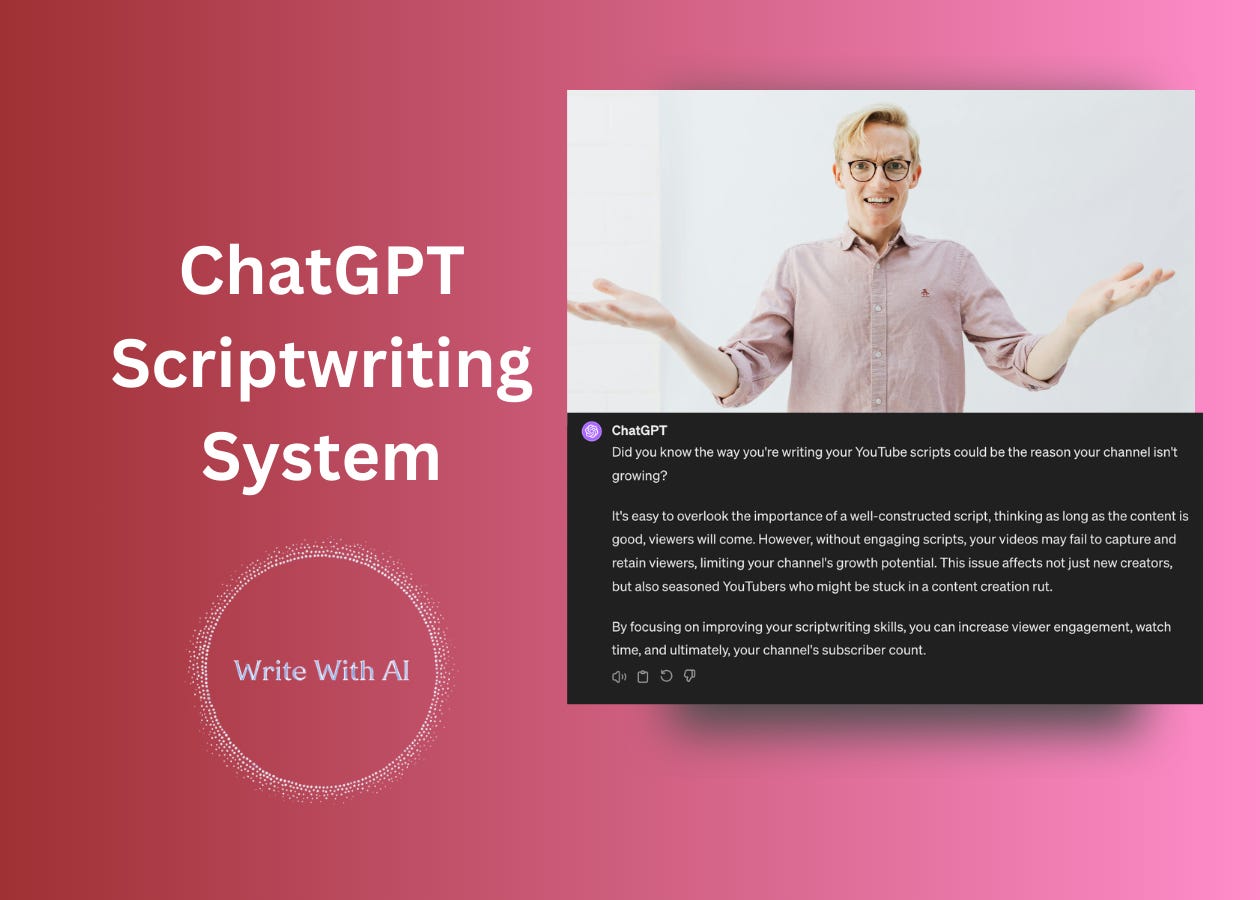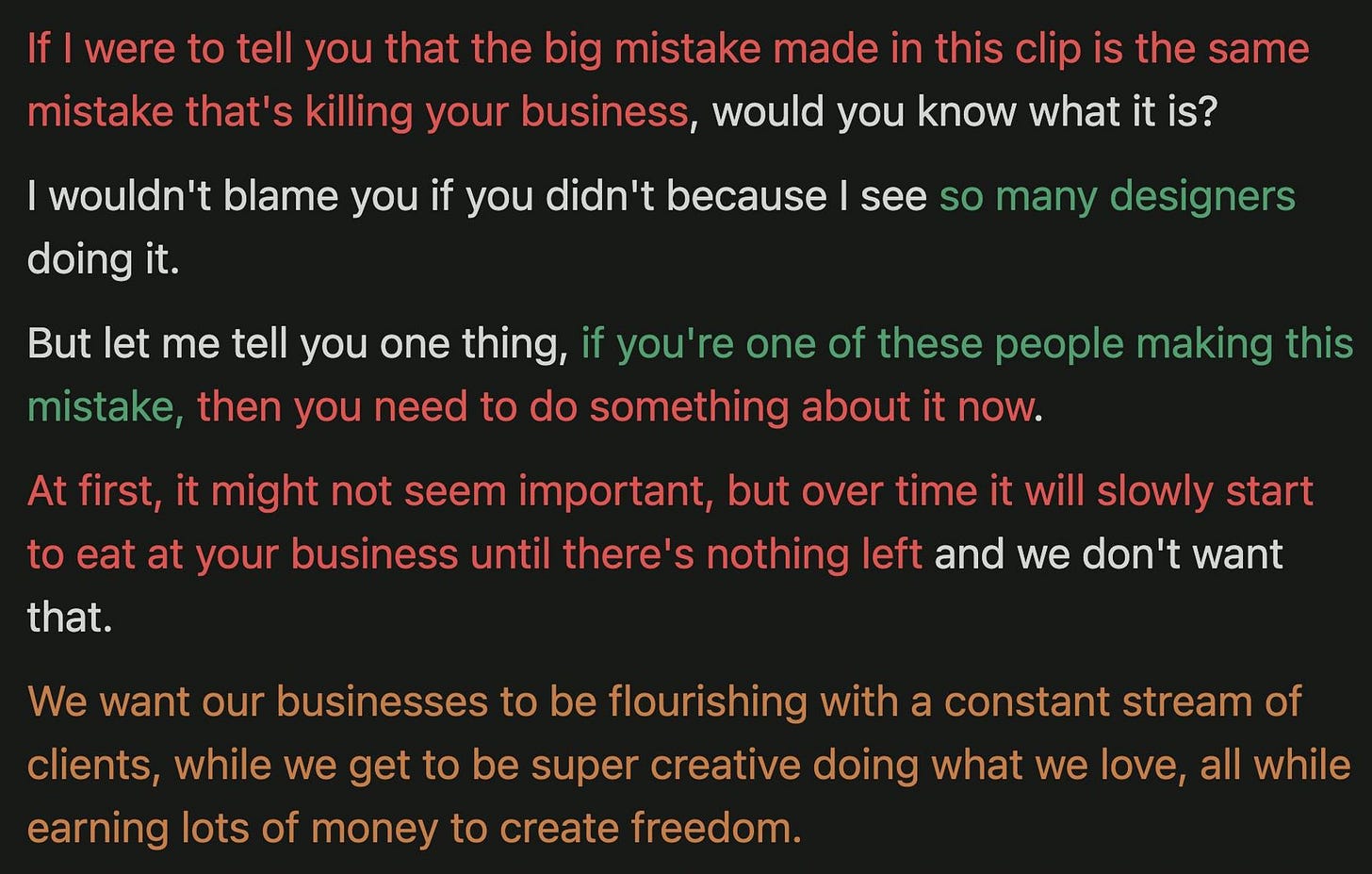Write A Killer YouTube Script Like George Blackman
Hook + Value + CTA
Ahoy Digital Writers!
In the last 3 weeks, we’ve had several subscribers asking for help writing YouTube Scripts.
So…
We brought in an expert.
Meet George Blackman.
George started as a full-time scriptwriter for Ali Abdaal, and has since worked with creators between 30,000 subscribers, all the way up to 10,000,000. He educates both YouTubers and writers about the impact scriptwriting can have on a channel.
Whether your goal is to increase retention, target the “right” viewers, boost AVD, skyrocket end-screen CTR, or simply make the process of making a video less stressful…
You can learn it ALL from George.
Here’s George…
👋 Hey there -
Wouldn’t it be nice to know how likely your script is to engage your audience?
Well, most creators ignore a simple trick that will (mostly) help you do this.
If you’ve never tried it before, this'll take 5 minutes to learn.
And, better still, it’ll take you even less time to apply what you learn with ChatGPT.
Let’s dig in.
3-Step Framework For Writing Killer Hooks
You might have seen me talking about these key components of a hook in the past:
The framework looks slightly different depending on whether your content is primarily educational, or entertainment-based.
But in a nutshell…
The audience needs to know what they’ll experience and why it matters.
Simple enough.
But…
I want to show you a hook I wrote that failed to use this technique (and suffered as a result).
"Sometimes sponsorships go completely wrong, so let's talk about the three mistakes you can avoid and the three situations that are out of your control."
Looks ok, right?
Since the script is for an educational video, we’ll break it down using the 3-step hook framework…
Let’s take a look at the hook again, but with the sentences highlighted to represent their intention.
Notice anything?
It turns out, this ok-looking hook contains none of those key components.
We’ve got some “stakes”, but no “target” or “transformation”.
Ok, the target audience is implied because of the title, so maybe we don’t need to mention them explicitly.
But the transformation - the very reason the audience should give us their time - is never mentioned.
This is bad news.
It’s not enough simply to say “we’ll talk about XYZ” - we need to explain how the audience will be transformed and why that matters.
Today, I’d have written the hook like this:
You’ll also notice I carefully adapted the line about the situation being “out of your control”.
Saying something like that in your hook is totally self-defeating - it makes the audience feel like their situation is hopeless.
Here’s another example…
This is from a video by Abi Connick, which I reviewed last year…
Let’s break down those key components, based on her hook…
Target: Graphic designers worried about their business failing.
Transformation: They’ll learn what the mistake is so they can avoid it and create a flourishing business.
Stakes: Unless they learn the lesson, their business is at risk of failure.
Hook Transcript:
I probably would have trimmed a couple of extra words here.
Nonetheless, every single sentence here is crucial to setting up the content.
And with 86% retention after 30s, you really can’t complain.
See how this works?
Focus on clearly signposting each of these three factors within your hook, and be brutal about cutting the rest.
Now, let’s look at the bit immediately after the hook.
Setup, Tension, Payoff
After the hook, it’s important that your audience always has something to look forward to in the next 60-90 seconds.
I call these “mini-payoffs”, and we need to include these to give our audience little dopamine hits throughout the video (rather than waiting until the end for any release of tension).
In a tutorial, this could be as simple as the moment we complete “step 1”.
In an entertainment video, it might be the moment a character discovers the first “tool” they’ll need to complete the challenge (or whatever).
But the key isn’t simply to include these mini-payoffs, but to let the audience know they’re coming.
To do this, break each mini-payoff into these components:
Setup: They need to know what they’re going to learn/see in the next 60-90 seconds.
Tension: They need to feel excited as you build towards that payoff.
Payoff: You provide the payoff in a satisfying way.
For the sake of color coding:
Let’s go back to the video I wrote for Justin.
I’ve copied the transcript below, using the color coding to assess whether I’ve used “setup, tension, payoff” correctly.
You might notice… not a single part of this segment contains any tension. And why?
Because I gave the payoff instantly.
This is particularly frustrating because the second paragraph is so clearly perfect as a set-up for the segment.
It appeals directly to the audience’s own experiences and empathizes with them.
And this is ideal when you’re introducing a new segment - it’s easy to lose viewers between topics, so grabbing them emotionally is essential at the start of each new one.
However, by starting with the payoff, the explanation loses its tension, and the second paragraph (which could have been a great set-up) becomes pure waffle.
In under 1 minute, we’ve lost 43% of the audience.
Today, I’d have written it like this:
Of course, this isn’t a technique you have to use forever.
After a while, you’ll start to notice these problems intuitively, and the need to highlight things will reduce.
As with almost anything on YouTube, it’s about re-wiring your brain ever so slightly to help boost the potential of your videos.
But to speed things along let’s see if we can get AI to help us to write script patterns for us.
Write A YouTube Script With ChatGPT
I broke this up into two separate prompts.
The Hook
The Payoff
Step 1: Write The Hook
To begin, ask yourself “What is my video about?”
Write it down in a short sentence. For example, “How to write a YouTube Script.” Then get more specific by adding in your target audience and the promise you are making to the viewer like this: “How to write a retention boosting YouTube script in < 5 minutes with AI.”
Add the context for your video in the below prompt.
Today we are going to apply the "Target-Transformation-Stakes" framework.
# Task
Write a text about [WHAT YOUR VIDEO IS ABOUT] following the "Target-Transformation-Stakes" for them consisting of the three parts "Stakes", "Target", and "Transformation"
Target: Use 3 sentences to raise the stakes and make sure it’s clear the viewer knows it’s for them and why it matters.
Transformation: Use 1 sentence to let the reader know what personal transformation/benefit they can expect. Be very specific about the outcome: tangible, specific, real, noun-oriented outcomes.
Stakes: Use 1 sentence to let the viewer know what’s at stake. This can be a bold statement, a thought-provoking question, a controversial opinion, or a a weird, unique insight. Avoid using the word "stakes."
# Role
Act as an expert ghostwriter and scriptwriter.
# Constraints
Avoid metaphors.
Avoid antithesis phrases.
Avoid purple prose AT ALL COSTS
Avoid words like "imagine, streamline, realm, game-changer, unlock, discover, skyrocket, abyss, vast, you're not alone, in a world where, revolutionize, etc"
# EXAMPLE 1: "Target-Transformation-Stakes" text.
If I were to tell you that the big mistake made in this clip is the same mistake that's killing your business, would you know what it is?
I wouldn't blame you if you didn't because I see so many designers doing it.
But let me tell you one thing, if you're one of these people making this mistake, then you need to do something about it now.
At first, it might not seem important, but over time it will slowly start to eat at your business until there's nothing left and we don't want that.
We want our businesses to be flourishing with a constant stream of clients, while we get to be super creative doing what we love, all while earning lots of money to create freedom.
# EXAMPLE 2: "Target-Transformation-Stakes" text.
Every creator wants to make predictable income for their business. But, even the most promising sponsorships can go completely wrong.
So let's talk about the three mistakes you’re probably making that are ruining your sponsorship strategy, and the three red flags to look out for from brands so you can continue to grow your business with consistent sponsorship revenue.
# Writing Style
Write in the same style and tone as the EXAMPLE - plain and simple.
Take a deep breath and try your hardest. You got this.
Note: If ChatGPT ignores the “game-changing” constraints in the prompt, remind it that it failed. For example, “Oops, it looks like you forgot to follow the constraints. Please try again.”
Step 2: Script The Payoff For Each Main Point
Now, add all of the main points you plan to cover in your video into the below prompt.
For example:
Keep reading with a 7-day free trial
Subscribe to Write With AI to keep reading this post and get 7 days of free access to the full post archives.












